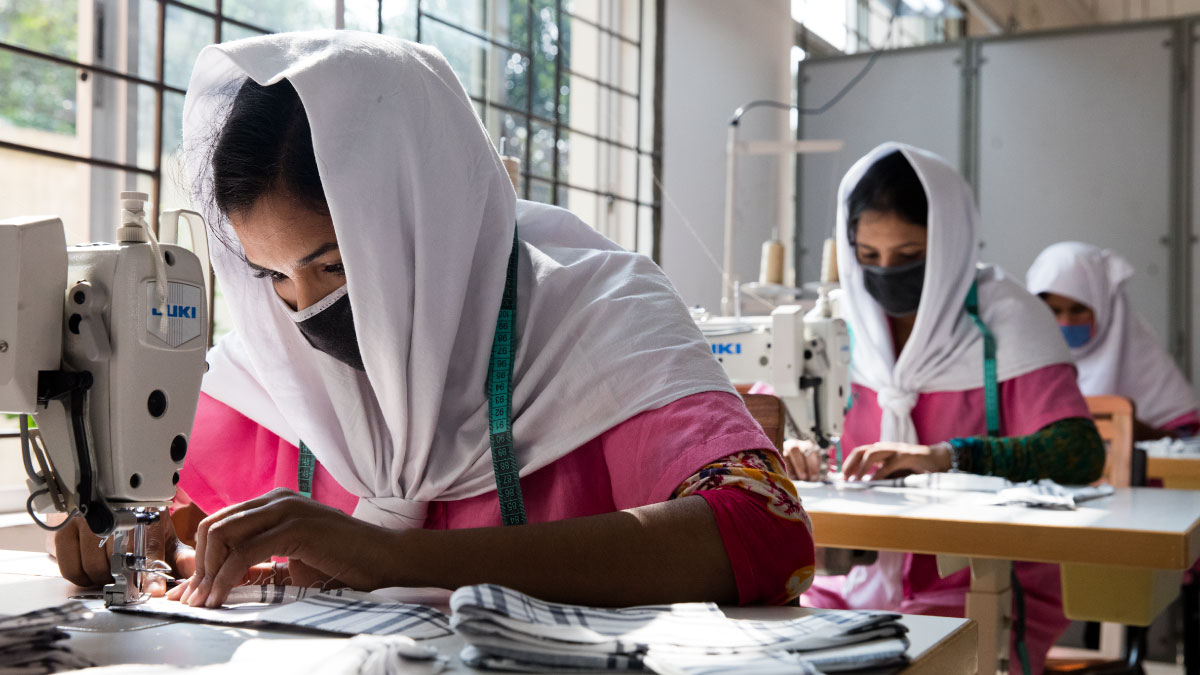Without better state capacity – ability to accomplish policy goals – the world’s poorest countries will remain on the margins of the global economy.
Young Bangladeshi women being trained at the Savar Export Processing Zone training center in Dhaka, Bangladesh. © World Bank/Dominic Chavez
The development of productive capacities in least developed countries (LDCs) is necessary for boosting their ability to respond to and recover from crises such as COVID-19, and to advance towards sustainable development, says UNCTAD’s Least Developed Countries Report 2021 released on 27 September.
UNCTAD defines productive capacities as “the productive resources, entrepreneurial capabilities and production linkages that together determine the capacity of a country to produce goods and services and enable it to grow and develop.”
Developing productive capacities allows the world’s poorest countries to foster structural economic transformation, which will in turn help reduce poverty and accelerate progress towards the UN Sustainable Development Goals (SDGs), the report says.
Reaching SDGs, however, requires massive investment and spending, which go well beyond LDCs’ financial means.
“Today LDCs find themselves at a critical juncture,” said UNCTAD Secretary-General Rebeca Grynspan. “They need decisive support from the international community to develop their productive capacities and institutional capabilities to face traditional and new challenges such as the COVID-19 crisis and climate change.”
50 years of struggle for development
The UN established the LDC category 50 years ago. The grouping of the world’s weakest economies has expanded from an initial 25 countries in 1971, peaking at 52 in 1991, and stands at 46 today, with only six countries having graduated – stopped being an LDC – to date.
“Strong economic growth in LDCs since the mid-1990s has generally been insufficient to redress their long-term income divergence with the rest of the world,” the report says.
Only a handful of LDCs have displayed, over the last two decades, some encouraging signs of incipient structural transformation and meaningful productivity improvements.
Grim outlook
The outlook for LDCs is grim. Mired in the health, economic and social crises brought about by the COVID-19 pandemic, in 2020 they recorded their worst growth performance in about three decades.
The COVID-19 crisis has dramatically highlighted the institutional, economic and social shortcomings of the development path followed by most LDCs, the report says.
“The pandemic has severely affected LDCs due to their reduced resilience and diminished capacity to react to the COVID-19 shock and its aftermath,” the report says.
LDCs’ limited resilience is reflected in their low COVID-19 vaccination rates, as only 2% of their population has been vaccinated, compared with 41% in developed countries.
Ms. Grynspan urged LDCs’ development partners to consider the special needs of the more than 1 billion people living in these countries during UNCTAD’s 15th quadrennial conference to be held online from 3 to 7 October, under the theme “From inequality and vulnerability to prosperity for all”.
Daunting financing needs
The UNCTAD report says LDCs’ financing needs to achieve the SDGs are daunting, especially in relation to the targets related to structural transformation.
For example, the report estimates that average annual investment requirements to reach the 7% growth target (SDG 8.1) is of the order of $462 billion, while the average annual investment requirements to end extreme poverty (SDG 1.1) in LDCs is estimated at $485 billion.
Financing needs to pursue meaningful structural transformation, thus paving the ground for decisive advances towards sustainable development. The average annual investment requirements to double the share of manufacturing in GDP (SDG 9.2) is estimated at over $1 trillion. This amounts to more than three times the fixed investment of LDCs in 2019.
To mobilize sufficient development finance, the report says LDCs will need to strengthen their fiscal capacities, increase domestic resource mobilization and improve the effectiveness of public expenditures. But this will not be enough.
“The international community has an essential role to play in supporting LDCs in their efforts to mobilize adequate financing for their sustainable development needs,” the report says.
According to the report, official development assistance (ODA) in LDCs displays weak catalytic impact on government expenditure because of the lack of synergy between ODA allocations and development priorities articulated by national development plans. This needs to be corrected.
A call to invest in state capacity
UNCTAD is calling for increased investment in state capacity and productive capacities in LDCs, as the COVID-19 crisis and the emerging two-speed global recovery threaten to reverse many hard-won development gains in these countries.
Most LDCs will take several years to recover the level of GDP per capita they had in 2019. The median LDC would take roughly three years to climb back to that level, while one third of the 46 LDCs are expected to take five or more years, according to UNCTAD’s analysis.
“For LDCs to transform their economies in the post-pandemic period, they must expand their local enterprise base through investments in productive capacities,” said Paul Akiwumi, director of UNCTAD's division for Africa and least developed countries.
Mr. Akiwumi said LDCs’ domestic efforts need to be supported by a new generation of international support measures that are more closely aligned to LDCs’ expressed needs and 21st century realities, especially in terms of technology transfer.
“A purposeful industrial policy should be at the core of LDCs’ pursuit of green growth and structural transformation”, Mr. Akiwumi said, because these countries need to urgently diversify from their overdependence on primary commodities.
Mr. Akiwumi added that increasing investment in state capacity and productive capacities must be at the heart of the next programme of action for these countries for the decade 2022 to 2031, to be adopted at the 5th UN Conference on LDCs in January 2022.
He also urged LDC governments to adapt programmes negotiated at the international level to their unique national conditions and to resolve trade-offs when formulating their national developments plans.

